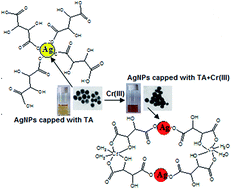Localized surface plasmon resonance of silver nanoparticles for sensitive colorimetric detection of chromium in surface water, industrial waste water and vegetable samples†
Abstract
Silver nanoparticles capped with tartaric acid (AgNPs/TA) are used as a localized surface plasmon resonance (LSPR) colorimetric sensor for the determination of chromium in real surface water (pond water and tube well water), industrial waste water and vegetable (cauliflower, tomato, spinach, green beans and cabbage) samples. The plasmon colorimetric sensing of chromium (+III and +VI) in samples was performed by measuring the change in the LSPR band in the UV-visible region of spectra. The reason for the change in the LSPR band was due to the aggregation of NPs induced by the coordination complex between chromium ions and tartaric acid present on the surface of NPs. The calibration curve gave a high level of linearity in the range of 5–100 μg L−1 for Cr(III) and 10–100 μg L−1 for Cr(VI) with a correlation coefficient of 0.996 and 0.995, respectively. The limits of detection (LODs) for Cr(III) and Cr(VI) were found to be 2 μg L−1 and 3 μg L−1, respectively, with the relative standard deviation percentage (RSD, %) in the range of 2.3–4.0%. The proposed method is found to be very simple, rapid and sensitive for the determination of trace levels of chromium present in surface water, industrial waste water and vegetable samples.


 Please wait while we load your content...
Please wait while we load your content...